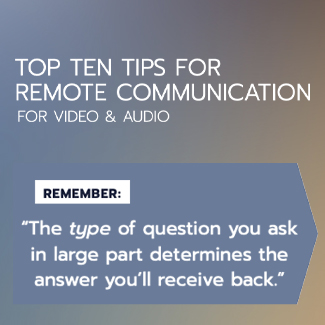- GK is offering our online Remote Communication course for free to anyone who has been laid off or furloughed. For more information email us at
- info@stage.gktraining.com

Videoconferencing Apps Worth Knowing
May 10, 2020
Ten Rules to Keep Facebook Fights Fair
October 29, 2020
Should You Bring Up COVID-19 On Business Calls? The Answer: It All Depends

By: Michael Chad Hoeppner Founder & CEO Published: May 26th 2020
You’re kicking off a phone or Zoom call with a client or prospect. Should you bring up the coronavirus? Or will it kill the positive vibes you’re trying to create? And if you are going to talk COVID-19, what’s the best way to do so?
Your business calls matter now more than ever. Every time you speak with a prospect, client, or team member, it’s a unique opportunity to offer some ease and structure in a stressful and chaotic moment. As the founder of a communications training company, adjunct professor at Columbia Business School and advisor to Presidential candidates, I listen to business calls countless times each week. I want to offer you a roadmap to make those calls as efficient and empathetic as possible.
The magic word these days: intentionality. But what does increasing intentionality on calls look like?
To start, determine if the call is one in which you’re open to sharing and discussing thoughts about the pandemic.
If you determine it is appropriate to give room for an open conversation, rule number one is to use a more specific and nuanced question than “How’s it going?” or “How are you?” Those types of questions are so de rigeur that people don’t even note them and will often reflexively respond, “Fine, how are you?” when it’s very likely, in fact, that person isn’t feeling “fine” at all.
That subtle first moment of inauthenticity tends to make the call feel false. It undermines trust and opportunities for empathy. Instead, consider adding a simple next noun or phrase at the end of that question to give the person license to answer the question honestly. Try adding any of these endings: “How’s it going for you today,” or “How’s it going…with this situation?”, or “How’s it going with everything that’s going on?” Even better, make the entire question more specific: “How are you navigating these unprecedented times?”
Next, if a conversation does develop and goes into the person’s feelings, situation, and experience relative to COVID-19, do not assume your experience is theirs. In any difficult situation, some outcomes can literally be life and death, some are career- or life-changing, while others are just annoyances or obstacles.
It is your job to empathize and respect whatever situation that person is facing. Be exceedingly careful with sharing the implications the situation has for you in a way that seems overly dramatic. For example, a crisis may have caused you to have to change housing situations; someone else may have had a family member pass. Equating your situation to theirs risks deeply damaging the relationship. Instead, listen first. Share concern and empathy. Share your experience when appropriate, but only through a sense of a shared relationship, not to demonstrate your own hardship.
Maybe you have a sense that your interlocutor doesn’t want to talk corona. That’s fine, too. If this is essentially a transactional conversation, set your listeners at ease by letting them know this will not be a time in which they need to plumb the depths of their coronavirus reality. Some semblance of business proceeding as usual can be comforting, too.’t want to be looking elsewhere without checking in frequently—as you would in everyday conversation—or you’ll risk looking shifty or unengaged.
In those circumstances, make a conscious choice to begin the call by thanking your conversation partner, acknowledging the situation, complementing him or her for dedicating their time, and get to the business at hand as efficiently as possible. Participants will thank you for putting some much-needed time back into their day instead of heading down the rabbit hole of COVID 19 facts and fears. What that sounds like differs for each person, but something like the following scripts fit the bill.
If you’re leading a conference call: “Hi everyone. I want to start by thanking every one of you for taking the time to be on this call. I recognize we’re in a tremendously stressful and chaotic time. I promise I will keep this call as efficient as possible so that you can get back the multiple things you are juggling. Let’s dive right in…”
If having a one-to-one call: “I can imagine you are juggling so many things with the current state of the world. I appreciate you taking the time to chat. I want to get right to it and…”
In many ways the pandemic asks us to radically heighten our focus in our daily intentions. What do I intend to do in this moment? Base-level intentions are simple and also essential: wash your hands, don’t touch your face, stay at home. But there are multiple other layers of intention: reach out to friends with more patience, regularity, and attention; evaluate our biases (ageism, for example) with more self-reflection; appreciate the un-sung heroes we overlook (those who deliver food, work in hospitals, keep the electricity on).
The person you’re talking to on the other end of the phone needs your attention and intention too. Today’s an opportunity to offer exactly that.



